Magnetism and electricity: Identify, describe and apply principles of magnetism
Unit 1: Magnets and magnetic fields
Leigh Kleynhans
Unit outcomes
By the end of this unit you will be able to:
- Draw and label diagrams showing the magnetic field of permanent magnets.
- Describe the effect that poles of permanent magnets have on each other.
What you should know
Before you start this unit, make sure you can:
- identify and apply the principles of forces, as covered in Subject outcome 2.2, Unit 1.
Introduction
This unit[1] is about magnets and magnetic fields. is an interaction that allows certain kinds of objects, which are called ‘magnetic’ objects, to exert forces on each other without physically touching. A magnetic object is surrounded by a magnetic ‘field’ that gets weaker as one moves further away from the object. A second object can feel a magnetic force from the first object because it feels the magnetic field of the first object. The further away the objects are the weaker the magnetic force will be.
Magnetic fields
A is a region in space where a magnet or object made of magnetic material will experience a non-contact, magnetic force.
A moving charged particle has a magnetic field associated with it. One example of a charged particle that occurs in most matter is the electron. Electrons are in constant motion, orbiting the nucleus in the atom which may also be moving, rotating or vibrating.
So electrons inside any object are moving and have magnetic fields associated with them. In most materials these fields point in various directions, so the net magnetic field is zero. For example, in the plastic ball below, the directions of the magnetic fields of the electrons (shown by the arrows) are pointing in different directions and cancel each other out. Therefore, the plastic ball is not magnetic and has no magnetic field.

In some materials, for example iron, there are regions called where the electrons’ magnetic fields line up with each other. All the atoms in each domain are grouped together so that the magnetic fields from their electrons point the same way. These materials are called materials. Figure 2 shows a piece of an iron needle zoomed in to show the domains with the electric fields lined up inside them.
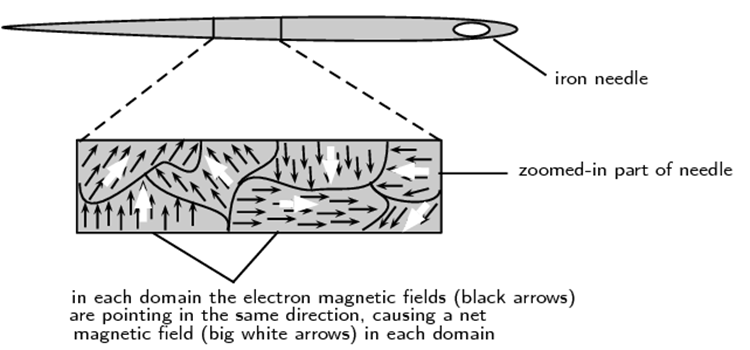
Permanent magnets
In permanent magnets, many domains are lined up, resulting in a net magnetic field. Objects made from ferromagnetic materials can be magnetised, for example by rubbing a magnet along the object in one direction. This causes the magnetic fields of most, or all, of the domains to line up in one direction. As a result, the object as a whole will have a net magnetic field. So it then becomes magnetic. Once a ferromagnetic object has been magnetised, it can stay magnetic without another magnet being nearby (i.e. without being in another magnetic field). In Figure 3 the needle has been magnetised because the magnetic fields in all the domains are pointing in the same direction.
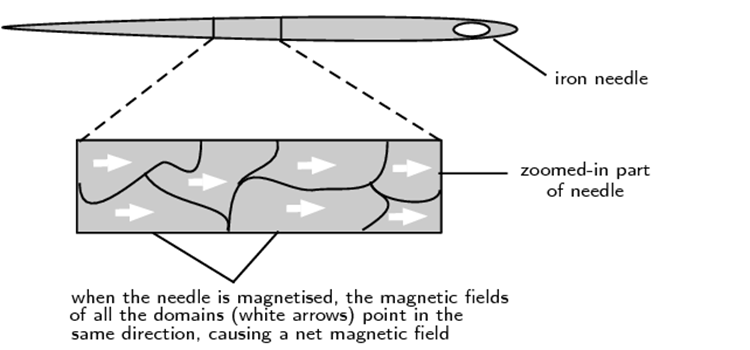
Because the domains in a permanent magnet all line up in a particular direction, the magnet has a pair of opposite poles, called north (usually shortened to N) and south (usually shortened to S). Even if the magnet is cut into tiny pieces, each piece will still have both a N and a S pole. These magnetic poles always occur in pairs. In nature, we never find a north magnetic pole or a south magnetic pole on its own.
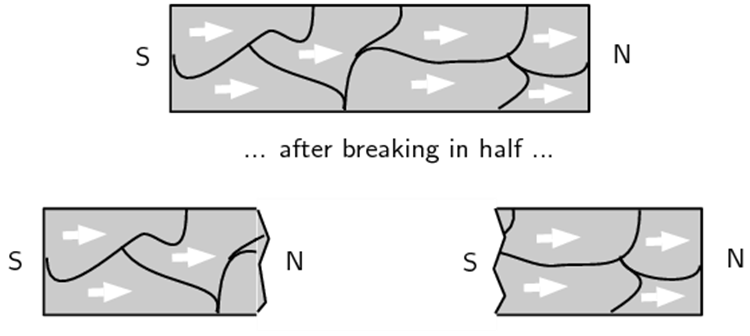
In nature, positive and negative electric charges can be found on their own, but you never find just a north magnetic pole or south magnetic pole on its own. On the very small scale, zooming in to the size of atoms, magnetic fields are caused by moving charges (i.e. the negatively charged electrons).
Like (identical) poles of magnets repel one another whilst unlike (opposite) poles attract. This means that two N poles or two S poles will push away from each other while N poles and S poles will be drawn towards each other.
Do you think the following magnets will repel or be attracted to each other?

In Figure 5 you can see two magnets with the N pole of one approaching the N pole of the other. Since both poles are the same, the magnets will repel each other.

In Figure 6 you can see two magnets with the N pole of one approaching the S pole of the other. Since the poles are different, the magnets will be attracted to each other.
Exercise 1.1
- If all substances contain moving electrons, why are only some substances magnetic?
- Give a word to describe substances that can be magnetised.
- Describe how you would position two bar magnets so that they would attract each other.
- Describe how you would position two bar magnets so that they would repel each other.
The full solutions are at the end of the unit.
Representing magnetic fields
Magnetic fields are invisible, so it is useful to draw diagrams to visualise them. Magnetic field lines are drawn to indicate the strength and direction of the magnetic field. The direction of magnetic field lines is determined by the direction in which a small compass needle will point when placed in the field.
Activity 1.1: Investigate the magnetic field around a bar magnet using a compass
Time required: 5 minutes
What you need:
- an internet connection
What to do:
- Open the link to the PhET simulation which shows a bar magnet and a small compass. [link:PhET Simulation (colorado.edu) ]
- Begin by dragging the compass around the bar magnet to see the direction the magnetic field points.
- Note the strength of the magnetic field which is represented by the brightness of the magnetic field icons in the grid pattern around the magnet.
- Use the magnetic field meter to check the field strength at several points around the bar magnet.
- Flip the polarity of the magnet and repeat.
What did you find?
The needle of the compass always points outwards from the north pole of the magnet and inwards at the south pole of the magnet. The field is strong near the poles and gets weaker as you move further away from the poles.
Although the magnetic field of a permanent magnet is everywhere surrounding the magnet (in all three dimensions), in a diagram we draw only some of the field lines to represent the field; usually only a two-dimensional cross-section is shown in drawings. Figure 7 shows how the magnetic field around a bar magnet is represented in drawings:
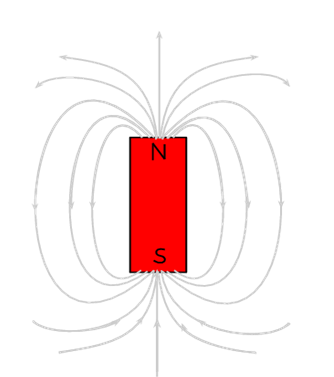
Features of magnetic field diagrams:
- The lines must never cross.
- The lines must have arrowheads pointing away from north and towards south.
- In areas where the magnetic field is strong (near the poles), the field lines are closer together. Where the field is weaker (further away from the poles), the field lines are drawn further apart.
- The number of field lines is referred to as the . The magnetic flux is used as a measure of the strength of the magnetic field.
As already stated, opposite poles of a magnet attract each other and bringing them together causes their magnetic field lines to converge (come together). Like poles of a magnet repel each other and bringing them together causes their magnetic field lines to diverge (bend out from each other).
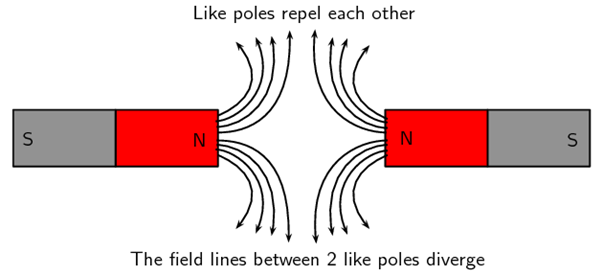

Note
For further explanation on magnetism, you can watch this video about Magnetism by Fuse Schools (Duration: 3.03).
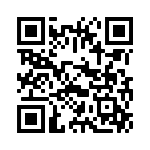
Summary
In this unit you have learnt the following:
- Magnets have two poles – north and south.
- Some substances can be easily magnetised by aligning the domains; these are called ferromagnetic substances.
- Like poles repel each other and unlike poles attract each other.
- Magnetic field lines are drawn to indicate the direction and strength of a magnetic field.
Unit 1: Assessment
Suggested time to complete: 10 minutes
- Describe a magnetic field.
- Explain how a substance can become magnetised.
- What happens to a magnet if it is cut into pieces?
- What happens if:
- two north poles are brought near each other?
- two south poles are brought near each other?
- a north pole is brought near a south pole?
- Draw the magnetic field:
- around a single bar magnet
- in the area between two magnets with a north pole facing a south pole
- in the area between two magnets with two north poles facing each other.
The full solutions are at the end of the unit.
Unit 1: Solutions
Exercise 1.1
- In order to have magnetic properties all the domains in the substance have to be aligned (face the same direction). This can only occur in some substances.
- Ferromagnetic
- Place the north pole of one magnet facing the south pole of the other magnet.
- Place two north poles facing each other or two south poles facing each other.
Unit 1: Assessment
- A magnetic field is a region in space where a magnet or object made of magnetic material will experience a non-contact, magnetic force.
- A magnet is rubbed against the substance and causes all the domains to become lined up in the same direction.
- Each piece will become a smaller magnet with a north and a south pole.
- .
- They will repel each other.
- They will repel each other.
- They will attract each other.
- .
- .

- .
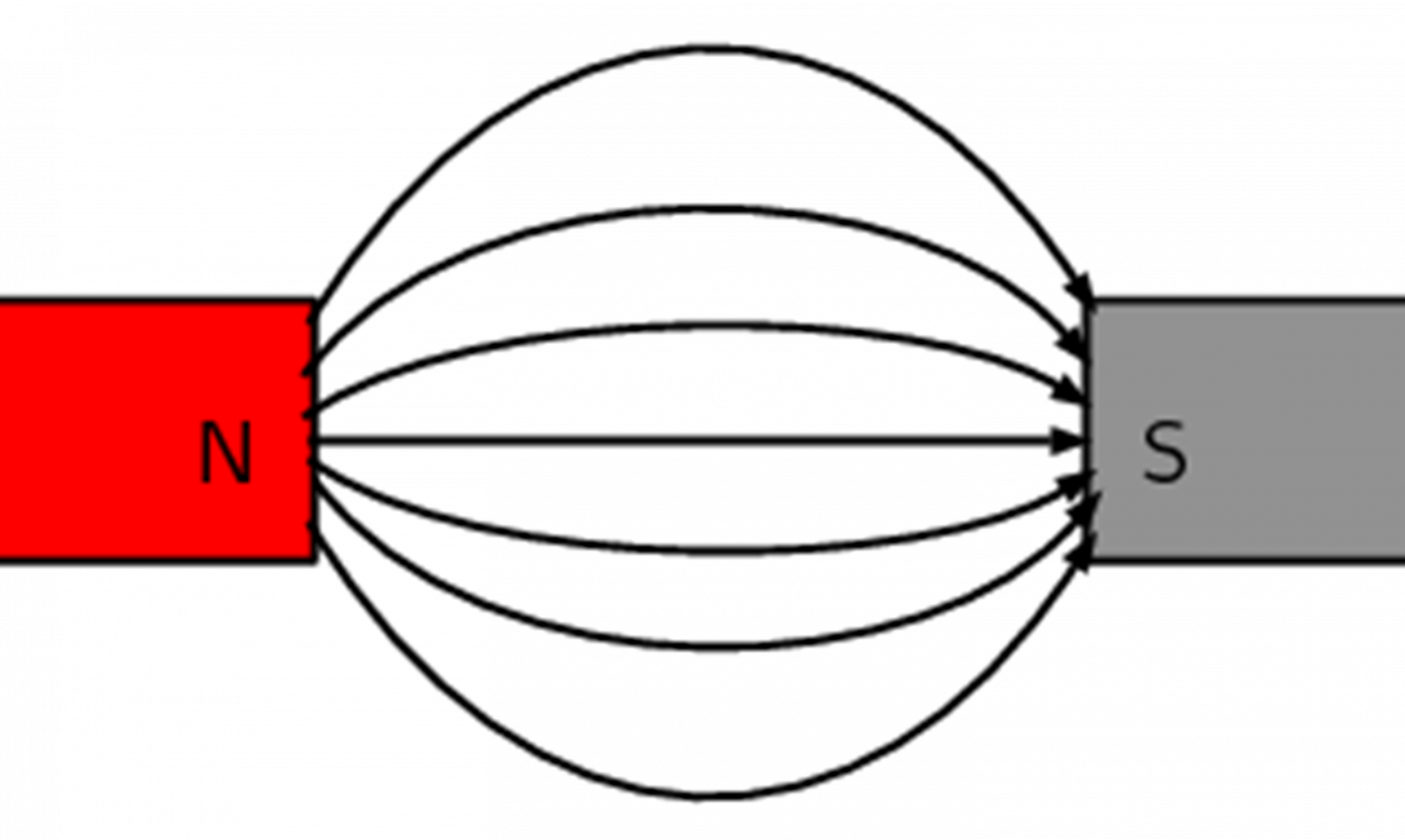
- .

- .
Media Attributions
- img01_Figure1 © Siyavula is licensed under a CC BY-NC-ND (Attribution NonCommercial NoDerivatives) license
- img02_Figure2 © Siyavula is licensed under a CC BY-NC-ND (Attribution NonCommercial NoDerivatives) license
- img03_Figure3 © Siyavula is licensed under a CC BY-NC-ND (Attribution NonCommercial NoDerivatives) license
- img04_Figure4 © Siyavula is licensed under a CC BY-NC-ND (Attribution NonCommercial NoDerivatives) license
- img05_Figure5 © Siyavula is licensed under a CC BY-NC-ND (Attribution NonCommercial NoDerivatives) license
- img06_Figure6 © Siyavula is licensed under a CC BY-NC-ND (Attribution NonCommercial NoDerivatives) license
- img07_Figure7 © Siyavula is licensed under a CC BY-NC-ND (Attribution NonCommercial NoDerivatives) license
- img08_Figure8 © Siyavula is licensed under a CC BY-NC-ND (Attribution NonCommercial NoDerivatives) license
- img09_Figure9 © Siyavula is licensed under a CC BY-NC-ND (Attribution NonCommercial NoDerivatives) license
- QR_Code_PSL2SO41U1_1
- img10(a)_AssessmentQ5answers © Siyavula is licensed under a CC BY-NC-ND (Attribution NonCommercial NoDerivatives) license
- img10(b)_AssessmentQ5answers © Siyavula is licensed under a CC BY-NC-ND (Attribution NonCommercial NoDerivatives) license
- img10(c)_AssessmentQ5answers © Siyavula is licensed under a CC BY-NC-ND (Attribution NonCommercial NoDerivatives) license
- Parts of the text in this unit were sourced from Siyavula Physical Science Gr 10 Learner’s Book, Chapter 15, released under a CC-BY licence ↵
an interaction that allows objects to exert forces on each other without physically touching
region in space where a magnet or object made of magnetic material will experience a non-contact, magnetic force
small regions in a substance where all the magnetic fields created by moving electrons are in the same direction
used to describe a substance that can be easily magnetised
the number of field lines in a magnetic field diagram indicating the strength of the field
